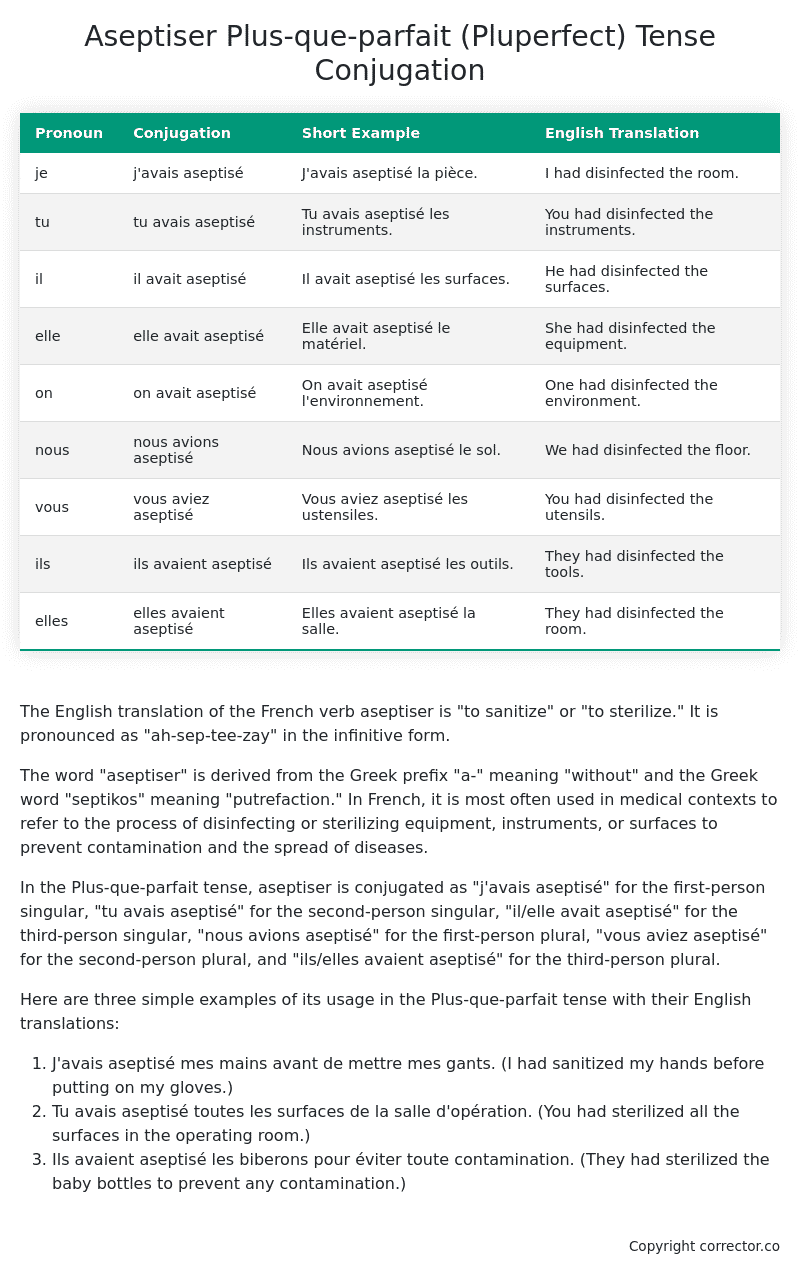Plus-que-parfait (Pluperfect) Tense Conjugation of the French Verb aseptiser
Introduction to the verb aseptiser
The English translation of the French verb aseptiser is “to sanitize” or “to sterilize.” It is pronounced as “ah-sep-tee-zay” in the infinitive form.
The word “aseptiser” is derived from the Greek prefix “a-” meaning “without” and the Greek word “septikos” meaning “putrefaction.” In French, it is most often used in medical contexts to refer to the process of disinfecting or sterilizing equipment, instruments, or surfaces to prevent contamination and the spread of diseases.
In the Plus-que-parfait tense, aseptiser is conjugated as “j’avais aseptisé” for the first-person singular, “tu avais aseptisé” for the second-person singular, “il/elle avait aseptisé” for the third-person singular, “nous avions aseptisé” for the first-person plural, “vous aviez aseptisé” for the second-person plural, and “ils/elles avaient aseptisé” for the third-person plural.
Here are three simple examples of its usage in the Plus-que-parfait tense with their English translations:
- J’avais aseptisé mes mains avant de mettre mes gants. (I had sanitized my hands before putting on my gloves.)
- Tu avais aseptisé toutes les surfaces de la salle d’opération. (You had sterilized all the surfaces in the operating room.)
- Ils avaient aseptisé les biberons pour éviter toute contamination. (They had sterilized the baby bottles to prevent any contamination.)
Table of the Plus-que-parfait (Pluperfect) Tense Conjugation of aseptiser
| Pronoun | Conjugation | Short Example | English Translation |
|---|---|---|---|
| je | j’avais aseptisé | J’avais aseptisé la pièce. | I had disinfected the room. |
| tu | tu avais aseptisé | Tu avais aseptisé les instruments. | You had disinfected the instruments. |
| il | il avait aseptisé | Il avait aseptisé les surfaces. | He had disinfected the surfaces. |
| elle | elle avait aseptisé | Elle avait aseptisé le matériel. | She had disinfected the equipment. |
| on | on avait aseptisé | On avait aseptisé l’environnement. | One had disinfected the environment. |
| nous | nous avions aseptisé | Nous avions aseptisé le sol. | We had disinfected the floor. |
| vous | vous aviez aseptisé | Vous aviez aseptisé les ustensiles. | You had disinfected the utensils. |
| ils | ils avaient aseptisé | Ils avaient aseptisé les outils. | They had disinfected the tools. |
| elles | elles avaient aseptisé | Elles avaient aseptisé la salle. | They had disinfected the room. |
Other Conjugations for Aseptiser.
Le Present (Present Tense) Conjugation of the French Verb aseptiser
Imparfait (Imperfect) Tense Conjugation of the French Verb aseptiser
Passé Simple (Simple Past) Tense Conjugation of the French Verb aseptiser
Passé Composé (Present Perfect) Tense Conjugation of the French Verb aseptiser
Futur Simple (Simple Future) Tense Conjugation of the French Verb aseptiser
Futur Proche (Near Future) Tense Conjugation of the French Verb aseptiser
Plus-que-parfait (Pluperfect) Tense Conjugation of the French Verb aseptiser (this article)
Passé Antérieur (Past Anterior) Tense Conjugation of the French Verb aseptiser
Futur Antérieur (Future Anterior) Tense Conjugation of the French Verb aseptiser
Subjonctif Présent (Subjunctive Present) Tense Conjugation of the French Verb aseptiser
Subjonctif Passé (Subjunctive Past) Tense Conjugation of the French Verb aseptiser
Subjonctif Imparfait (Subjunctive Imperfect) Tense Conjugation of the French Verb aseptiser
Subjonctif Plus-que-parfait (Subjunctive Pluperfect) Tense Conjugation of the French Verb aseptiser
Conditionnel Présent (Conditional Present) Tense Conjugation of the French Verb aseptiser
Conditionnel Passé (Conditional Past) Tense Conjugation of the French Verb aseptiser
L’impératif Présent (Imperative Present) Tense Conjugation of the French Verb aseptiser
L’infinitif Présent (Infinitive Present) Tense Conjugation of the French Verb aseptiser
Struggling with French verbs or the language in general? Why not use our free French Grammar Checker – no registration required!
Get a FREE Download Study Sheet of this Conjugation 🔥
Simply right click the image below, click “save image” and get your free reference for the aseptiser Plus-que-parfait tense conjugation!

Aseptiser – About the French Plus-que-parfait (Pluperfect) Tense
Tense Formation
Common everyday usage patterns
Sequencing of past events
Background information
Hypothetical or reported speech
Interactions with other tenses
Summary
I hope you enjoyed this article on the verb aseptiser. Still in a learning mood? Check out another TOTALLY random French verb conjugation!


